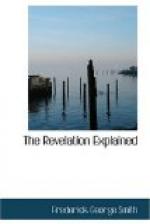To be a pillar in this temple of God means to occupy a conspicuous or useful position in supporting the truth, examples of which are to be found in such characters as “James, Cephas, and John, who seemed to be pillars” in the church in apostolic times. Gal. 2:9. In the last prayer of Christ to the Father, he says concerning his disciples, “While I was with them in the world, I kept them in thy name” (John 17:12); and since the church promised by Christ (Mat. 16:18) has been established, we continually bear the name of the Father, its title being the church or city of God. We also bear the new name of Christ, as explained in chapter 2:17, and we meet together and worship in that name (Mat. 18:20), obeying the exhortation of the apostle Paul—“Whatsoever ye do in word or deed, do all in the name of the Lord Jesus, giving thanks to God and the Father by him.” Col. 3:17. A better understanding of the manner in which we receive the name of God and of his city will be obtained when we come to the consideration of the followers of a false, degenerate church represented as receiving the “mark of the beast,” by which they are designated.
To inquire further into the history of this church, Philadelphia still remains with a population of about fifteen thousand. It contains a number of places of public worship, a resident (Greek) archbishop, and several inferior clergy. Mr. Keith, in his “Evidence of Prophecy,” speaks of the then presiding bishop, and says that he acknowledges “the Bible as the only foundation of all religious belief” and admits that “abuses have entered into the church, which former ages might endure, but the present must put down.” It is also a singular coincidence that the modern Turkish name of the city, Ala-Shehr, signifies “city of God.”
This description of the church of Philadelphia I will bring to a close by adding the following extract from Gibbon, recorded in his noted history entitled “The Decline and Fall of the Roman Empire.” It is of especial value since the writer, being an avowed infidel, can not be convicted of misconstruing historical facts in order to favor Christianity.
“The captivity or ruin of the seven churches of Asia was consummated [by the Ottomans] A.D. 1312, and the barbarous lords of Ionia and Lydia still trample on the monuments of classic and Christian antiquity. In the loss of Ephesus the Christians deplore the fall of the first candle-stick of the Revelation. The desolation is complete; and the temple of Diana and the church of Mary will equally elude the search of the curious traveler. The circus and three stately theatres of Laodicea are now peopled with wolves and foxes. Sardis is reduced to a miserable village. The God of Mohammed without a rival is invoked in the mosques of Thyatira and Pergamus; and the populousness of Smyrna is supported by the foreign trade of the Franks and Armenians. Philadelphia alone has been saved by prophecy or courage.




